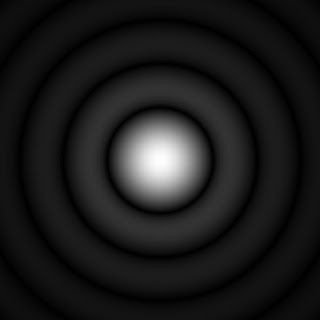In the errata, you will now find this entry:
Page 338: In Chapter 12, Problem 10. The final equation, a Bessel function integral, should be
Error found 6-10-14.In the 4th edition, we left out the leading factor of “u” on the right-hand-side. Why does this bother me so much? In part, because Problem 10 is about a famous and important calculation. Chapter 12 is about imaging, and Problem 10 asks the reader to calculate the two-dimensional Fourier transform of the “top hat,” function equal to 1 for r less than a (a circular disk), and zero otherwise. This Fourier transform is, to within a constant factor, equal to J1(u)/u, where J1 is a Bessel function and u = ka, with k being the magnitude of the spatial frequency. This function is known as the “Airy pattern” or “Airy disk.” The picture below shows what the Airy disk looks like when plotted versus spatial frequencies kx and ky:
 |
| The Airy disk. |
The Airy disk plays a particularly important role in diffraction, a topic only marginally discussed in IPMB. Interestingly, diffraction isn’t important enough in our book even to make the index. We do mention it briefly in Chapter 13
One property of waves is that diffraction limits our ability to produce an image. Only objects larger than or approximately equal to the wavelength can be imaged effectively. This property is what limits light microscopes (using electromagnetic waves to form an image) to resolutions equal to about the wavelength of visible light, 500 nm.We don’t talk at all about Fourier optics in IPMB. When light passes through an aperture, the image formed by Fraunhofer diffraction is the Fourier transform of the aperture function. So, for instance, when light passes through the objective lens of a microscope (or some other aperture in the optical path), the aperture function is the top hat function: all the light passes through at radii less than the radius of the lens, and no light passes through at larger radii. So the image formed by the lens of a point object (to the extent that the assumptions underlying Fraunhofer diffraction apply) is the Airy disk. Instead of a point image, you get a little blur.
Suppose you are trying to image two point objects. After diffraction, the image is two Airy disks. Can you resolve them as two separate objects? It depends on the extent of the overlap of the little blurs. Typically one uses the Rayleigh criterion to answer this question. If the two Airy disks are separated by at least the distance from the center of one Airy disk to its first zero, then the two objects are considered resolved. This is, admittedly, an arbitrary definition, but is entirely reasonable and provides a quantitative meaning to the vague term “resolved.” Thus, the imaging resolution of a microscope is determined by the zeros of the J1 Bessel function, which I find pretty neat. (I love Bessel functions).
So, you see, when I realized our homework problem had a typo and it meant the student would calculate the Airy disk incorrectly, my heart sunk. To any students who got fooled by this problem, I apologize. Mea culpa. It makes me all the more determined to keep errors out of the upcoming 5th edition, which Russ and I are working on feverishly.
On the lighter side, when I run into scientists I am not familiar with, I often look them up in Asimov’s Biographical Encyclopedia of Science and Technology. When I looked up George Biddell Airy (1801–1892), Astronomer Royal of the Greenwich Observatory, I was shocked. Asimov writes “he was a conceited, envious, small-minded man and ran the observatory like a petty tyrant.” Oh Myyy!



Another example of why you are so effective at what you do. Being correct is not your motive, passing on an understanding and making what you teach available as a useful tool that students can continue to use is.
ReplyDeleteGet on the MOOC train Brad! The world needs you!
ReplyDelete